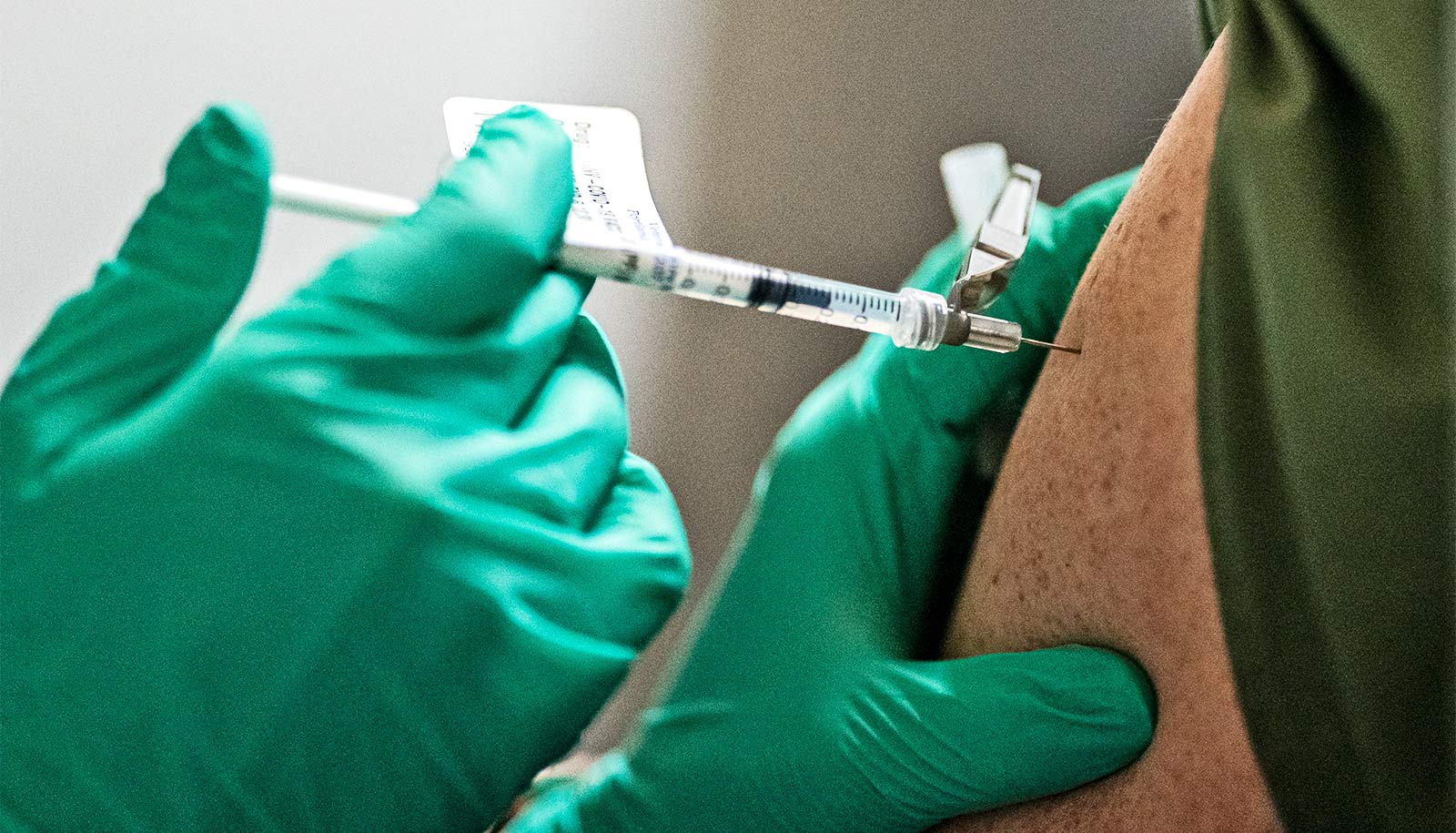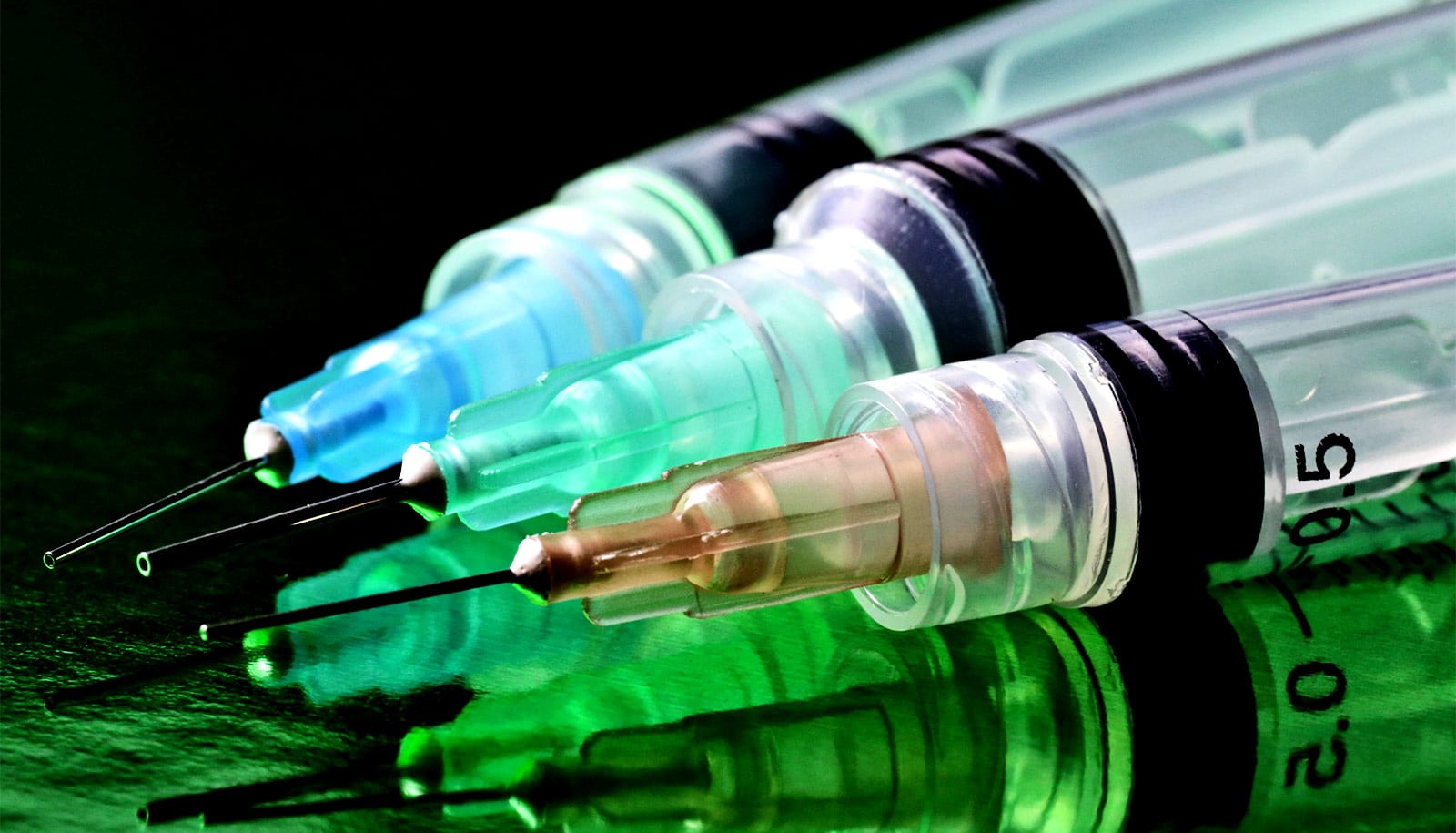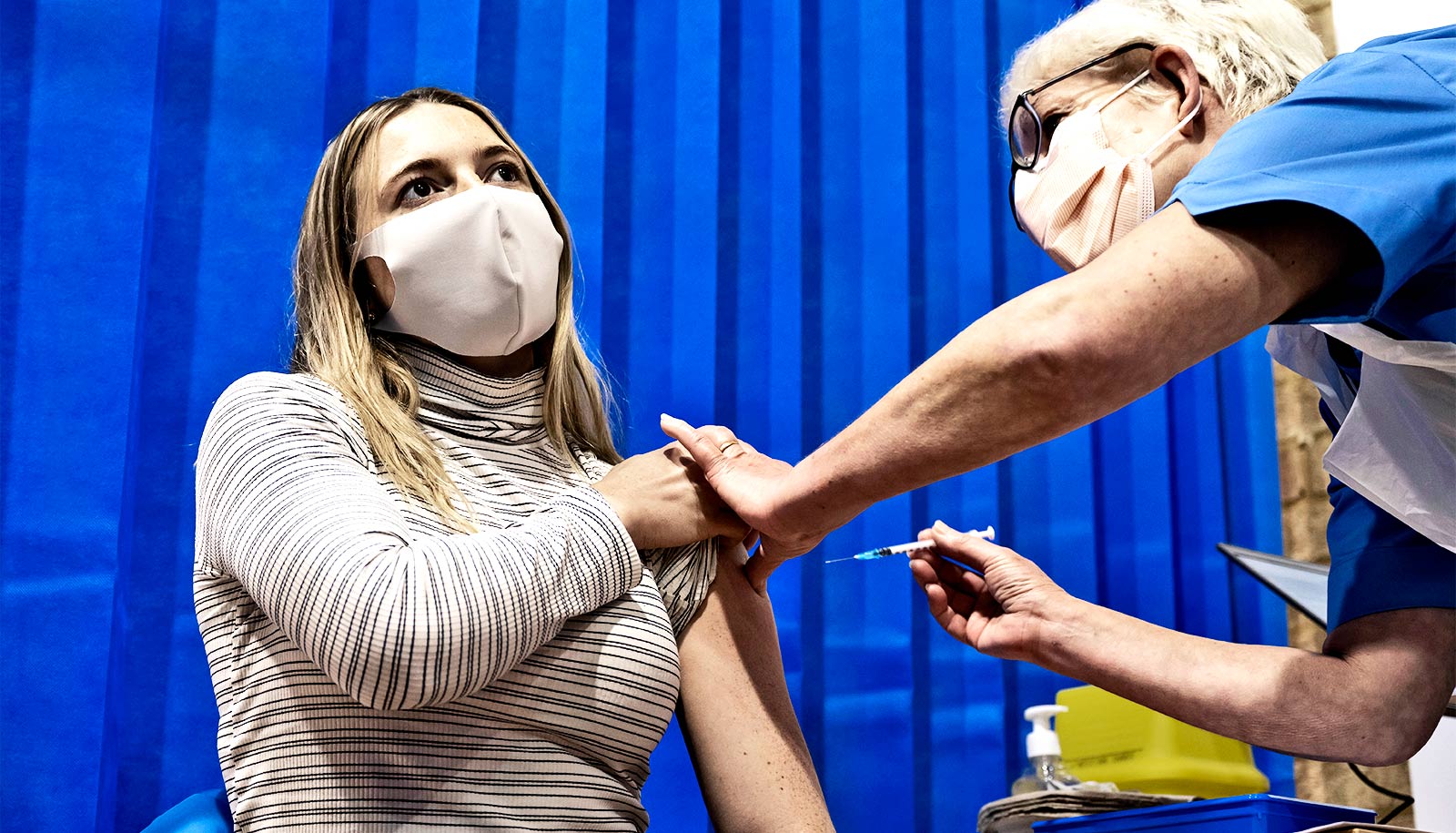Vaccines to help address the COVID-19 health crisis are now becoming available, but how do they work?
Here, Matt Koci, a professor in North Carolina State’s department of poultry science and a virologist and immunologist whose work focuses on host-microbe interactions in birds, explains the basics about vaccines and how mRNA and adenovirus vaccines work:
What are vaccines and how do they work?
If you think of getting sick from disease and letting your immune system fight it off as “on the job training,” then vaccines are the equivalent of vocational-technical school for your immune system.
There are a lot of things you can learn “on the job”: sweeping up, running the register, locking up at night. But there are a lot of skills at work where learning on the job can be dangerous. If you are getting new brakes, you want to be sure your mechanic already knows how to install them.
Vaccines teach the immune system how to recognize diseases, so that when you are exposed to the real disease, your immune system can respond immediately. Ideally, you’ll never even know you were infected.
This allows their immune system to develop the cells and proteins it needs to fight off the pathogen when they come across the real disease.
There are several different ways this can work. We can find (or even make) close cousins of a pathogen. Something that doesn’t make us sick, but still looks enough like the pathogen to give us immunity to both. This is known as an attenuated vaccine. Some of the most successful vaccines are attenuated vaccines. Smallpox, measles, and chickenpox vaccines are all attenuated vaccines.
Another major approach is what’s called an inactivated vaccine; the flu shot is a good example. Here, instead of a close cousin, we use the pathogen itself. But we can’t just inject the pathogen, because that will make everyone sick. So, we boil it or do something that otherwise makes the pathogen harmless.
We then use the inactivated pathogen to show the immune system what the pathogen looks like. The immune system uses that to develop the tools it needs to protect you from the real pathogen.
Still another approach is to make just a few of the proteins from the pathogen in the lab and inject those. This is called a subunit vaccine. The HPV vaccine is a good example of this kind of vaccine.
Then there are vaccines that don’t involve the pathogen or its proteins directly but rather trick your cells into making the proteins. These involve injecting DNA or RNA packaged in different ways. Some use protective chemical shells—or even other viruses—to deliver the vaccine.
In either case, the DNA or RNA is delivered to the inside of your cells. This then gets your cells to make the pathogen proteins, and those proteins then induce your immune system to develop resistance to the relevant pathogen. So in a sense, your cells make the vaccine.
There are currently over 100 potential COVID-19 vaccines in some stage of testing around the world. Across all these potential vaccines people are trying every kind of vaccine technology.
Over 100? What are the ones being developed for use in the US?
This is going to be a global effort, so we really can’t afford for there to be vaccines just for one country, but the US government put a lot of money into helping companies speed up the development time of their vaccines. That’s “Operation Warp Speed.”
Through that program the US invested about $11 billion in six different vaccines. Two of the vaccines in Operation Warp Speed are subunit vaccines, where the company is making viral proteins that will be used as the vaccine.
Three of the vaccines use different viruses that we’ve engineered to be harmless, but are still capable of inducing your cells to make the proteins we need your immune system to respond to. And the last one is just mRNA packaged in a protective shell.
The Pfizer vaccine is an mRNA vaccine right? That’s the one that has been authorized for use in the UK and the UK.
Yes. The Pfizer-BioNTech vaccine is the mRNA vaccine that was just granted emergency use authorization for use in the US and UK.
To be clear, Pfizer initially opted out of US funding for vaccine development from Operation Warp Speed, but will receive US support for distribution. There’s actually another mRNA vaccine close behind the Pfizer-BioNTech vaccine in the review process. That’s the one from Moderna, and that’s the one that Operation Warp Speed invested in more heavily from the start.
In fact, by the time anyone reads this, the Moderna vaccine will probably also have received its own authorization—the preliminary analysis from the FDA was promising.
What are mRNA vaccines? Have they been used in people before?
These vaccines fall under that last category of vaccines I mentioned above, where we effectively get your cells to make their own vaccines. But to answer this question we have to take a step back and explain what mRNA is. Bear with me for a second.
Your high school biology teacher likely told you that the flow of genetic information in a cell goes from DNA to RNA to protein. It’s one of the many concepts that likely made you mutter “when am I ever going to use this.” Well, send your teacher an apology, because today’s the day.
An organism’s genome is the complete set of genes and genetic instructions needed to make that organism. These genetic instructions are encoded in the DNA that is stored in the nucleus of nearly every cell in your body. These cells carry all that DNA around with it. But in order for your liver cell to be a liver cell and not a heart cell, your liver cells only follow the set of instructions in your genome related to liver cells.
Think of the genome like the reference section in a library that won’t let you check out books. If you need specific instructions on how to do something, you have to go to the library to read the book. And you take notes. You don’t copy the whole book, just the specific instructions you need for the job you’re doing. The way the cell takes these notes is by using a molecule called RNA, and we call these notes “messenger RNA” or mRNA. There are proteins in your cells whose job is to go into the nucleus and write down the specific instructions for certain tasks. These instructions, or mRNAs, are then carried to another part of the cell where they are used to build proteins.
Every protein a cell makes goes through this process. DNA is copied into RNA and that mRNA is translated into protein. Okay so far?
So, mRNA vaccines are just a type of vaccine where we package the RNA instructions for some of the SARS-CoV-2 proteins (the virus that causes COVID-19). We inject that mRNA into a person’s arm, the mRNA is introduced into cells in your body, and the SARS-CoV-2 mRNA is treated like mRNA that comes from the cell’s own nucleus and is translated into protein. Basically, the vaccine tricks your cells into creating these specific proteins from SARS-CoV-2.
However—and this is important—the vaccine doesn’t have the instructions to make the whole SARS-CoV-2 virus. Instead, it just makes the “spike protein,” which is what the virus uses to bind and get into our cells. The ultimate idea is that the vaccine drives the immune system to make cells and proteins that recognize and destroy the spike protein, which protects us from COVID-19.
This is a relatively new approach to making vaccines. The idea has been around for a while, but has not previously been used in a vaccine approved by the FDA. That’s not a comment on its safety or effectiveness—there are several different mRNA based vaccines working their way through the normal approval process. It’s just that normally that process is a lot slower.
What are the advantages to mRNA vaccines?
Probably the biggest advantage of this approach is, at least on paper, its simplicity. It’s just mRNA encoding the genes you want the immune system to respond to, and some sort of protective shell to help get it into the cells so it can be translated into protein to drive the immune response. This simplicity means vaccine companies can start making vaccine as soon as someone gives them the genetic sequence of the pathogen. So the biggest advantage is how quickly you can get started testing a new vaccine.
However, mRNA is extremely fragile and if not handled properly it can fall apart. If it does, that’s the end of your vaccine. That’s why this vaccine has to be kept extremely cold: -112 F or -80 C for the Pfizer vaccine and -4 F or -20 C for the Moderna vaccine. I’m not sure what Moderna is doing differently that allows them to get away with the warmer temperature but it still needs to be kept well below freezing.
If the mRNA vaccines are the first, what vaccines might be released next? I’ve also heard some talk about adenovirus vaccines. What are adenovirus vaccines? Are any of them being considered as COVID-19 vaccines?
Yes. Adenovirus-vectored vaccines are the other technology that has been close behind the mRNA-based vaccines in clinical testing. Of the six vaccines backed by Operation Warp Speed, the adenovirus vectored vaccines are the only other vaccines, besides mRNA vaccines, to make it to Phase III testing. That means, assuming things go well with this phase of testing, they will be the next ones that should get emergency use authorization—probably in January or February 2021.
Like the mRNA vaccines, the main idea behind adenovirus vaccines is to get genetic material that encodes SARS-CoV-2 genes into your cells and get your cells to make the virus proteins. The difference is in how they do this. Where the mRNA vaccine is just the mRNA protected by a chemical shell, adenovirus vectored vaccines use a virus we know is harmless to act as a Trojan horse. But instead of hiding Greek soldiers, or anything dangerous, the adenovirus releases genes that encode the SARS-CoV-2 spike protein.
Adenoviruses are a family of viruses that have dozens, maybe hundreds, of members. Most don’t cause any known disease, or they only cause mild “common cold”-like symptoms. Scientists developed a way to use strains of adenoviruses that don’t cause disease as a delivery system for vaccines. So we’re using one virus to deliver the vaccine against another.
The genes for the protein that we want the immune system to respond to are inserted into the adenovirus genome as DNA. Then the person to be vaccinated against SARS-CoV-2 is infected with this harmless adenovirus. When the adenovirus gets into your cells the DNA is turned into mRNA, causing the cells to make the vaccine proteins, which triggers the immune response. I’ll also point out that when we insert these vaccine genes into the adenovirus, we also remove genes from the adenovirus so that it can’t replicate in the vaccinated person. This is done as an added safety precaution.
Like the mRNA vaccines, this type of vaccine has been around as an idea for a while, and there are several adenovirus-vectored vaccines in phase 1 and 2 clinical trials but none that I’m aware of that are FDA approved and currently being used in people.
What are the advantages to adenovirus vaccines?
The biggest advantage here is, even though there aren’t any adenovirus-vectored vaccines being used in people today that I’m aware of, scientists have been using this technology in the lab for decades. The process of inserting genes into the adenovirus vectors is routine for a lot of labs. It does involve more steps than mRNA vaccines, but those steps have been optimized so it can still be done pretty quickly. That makes these types of vaccines easy to make a lot of quickly and relatively cheaply.
Also, once assembled, adenovirus-vectored vaccines are pretty stable, so they don’t have to be kept at really low temperatures.
One issue that has slowed down the development of these vaccines is all the other adenoviruses out in nature. Many don’t make us sick, and some are unknown to science. Vaccine producers have been trying to find the right adenovirus to use for the vaccine—one that your immune system hasn’t seen before.
If the adenovirus carrying the vaccine looks too much like an adenovirus your immune system has seen before, your immune system will attack and destroy the vaccine before it has a chance to do its job. Companies have been working for years to fix this issue. Looking at the early data from the Oxford/AstraZeneca and Johnson and Johnson trials suggests they may have succeeded.
So are you going to get the vaccine?
Yes. As soon as it is made available to me.
Source: NC State



